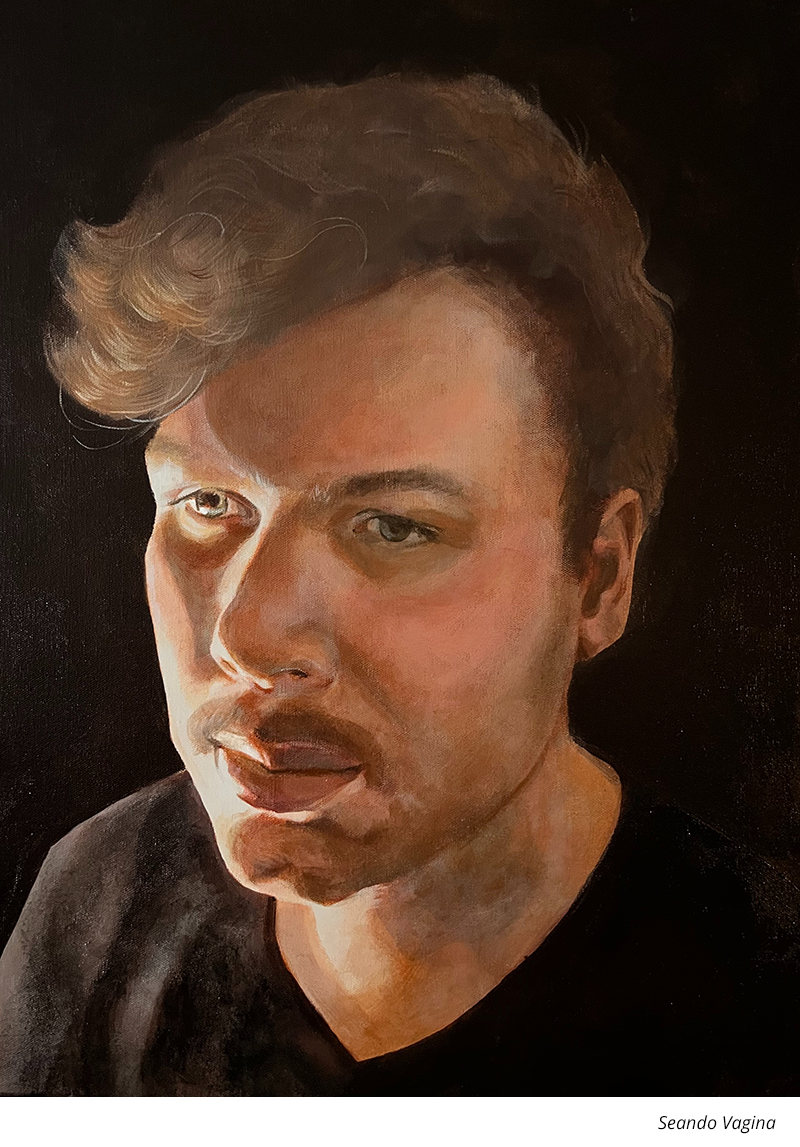
Tell a little bit about how you first got into creating art.
I remember drawing portraits of my pets on the backs of my dad's faxes. Making comics of fantasy warriors and reenactments of personal struggles, recreating famous paintings on the Etch-A-Sketch, and exquisite corpses helped me sit quietly for hours each week in church pews. I didn't have a lot of friends growing up and spent a lot of time in my backyard drilling holes, melting toys, testing the removal properties of acetone, building stuff for my chickens. Later on, fine art seemed a reasonable application for my natural proclivities. Materiality and creation has provided an itch to an existential scratch I've had since I was young.

The geometric motifs are imperfect, physical representations of ideas that exist in the strictly non-physical, conceptual realm
What artists or movements have had an impact on you?
When I started to spend more time in museums than church, conceptual art and minimalism were a big deal to me — Joseph Kosuth, Adrian Piper, Sol LeWitt, Carl Andre. Work that served to strip away anything fallible, unstable, deniable, material, to give way to and condense the infallible, logical, undeniable, immaterial, Truth, that's what I craved and sought. For the same reasons I was drawn to pre-Socratics as a teen, Parmenides and Heraclitus, the paths of Being vs. Becoming. As a young adult, I was inspired by institutional critique and relational aesthetics as a means of putting values into practice.
What themes does your work involve?
Truth, Ideas, Iteration, The Immaterial, Community, Beauty, Connection, Sublime

If creation is divinity, then we're all a bit divine
What is important to you about the visual experiences you create?
I am inspired by Plato's Theory of Forms; I want to make physical an idea. The geometric motifs are imperfect, physical representations of ideas that exist in the strictly non-physical, conceptual realm. What qualities do all particulars share, and how do these properties inform a universal ideal? What makes a chair a chair, a triangle a triangle, a tetrahedron a tetrahedron?
What is the significance of medium and color?
The industrial throughline of steel brings a utility and strength when used to depict symbols of universal ideals. I was initially drawn to metalwork over ten years ago because of the material's durability, and how the medium lends itself to industrial design applications. Employed as a picture frame, steel serves to encase and protect, pointing to and venerating the iterations of the depicted symbols they surround.

Most recently this season I've been making paintings of the polyhedra sculptures because I'm interested in the simultaneous 2D and 3D qualities of the forms: when photographed, the shapes become flattened like line drawings, points of connection that stretch and change along with the camera's vantage. The same sculpture can look like completely different forms when viewed from different angles. I've made woodcuts, tattoos, and collages that celebrate this shifting, flattening phenomenon. The paintings begin from this premise and depart by getting close and paying attention — indicating the subtle dimensionality and reflected light of the round stock material within these flattened two dimensional views, especially the compositions that are magnified and cropped. The colors in these paintings are made from mixing blue, red, and yellow, and tinting with white.
Do you work from memory, life, photographs, or from other resources? Describe your creative process.
My work will often start as a point of personal curiosity or an external request. "What would this idea look like if I used the fewest elements possible to represent it?" "What happens to the end result of a portrait if I use quinacridone magenta hot pink as an underpainting?" "Can you weld some handrails for our stairs that match our bathroom grab bars?" are all examples of some past springboards to particular works. In my own hand, I find renderings worked from photographs to be the most beautiful, so I tend to take pictures and work from those. Sometimes I use image transfer techniques so I can shortcut to the more interesting and enjoyable (to me) facets of making a painting: fast-forward to things like how to portray form within cast shadow, using value ranges to make dimensionality, relative color and how certain tints or shades of colors can influence those around them, stuff like that.
Do you have any artistic goals for the future that you would like to share?
If creation is divinity, then we're all a bit divine, I want to help others see the divinity in me, and in doing so, recognize the divinity in themselves. For example, I started doing tattoos and welding, learning new processes and materials about which I was curious. Turns out a lot of people like getting tattoos, and some people also want things like outdoor grills and handrails. Learning and becoming proficient in a procedure, nurturing that ability, and sharing it for the benefit of others is one of the things that make life worth living. I experience pain intensely, as most individuals do, and want to celebrate hurt as it defines relief and joy, to recognize the importance of angst and frustration as without them we would not know purpose, meaning, belonging. All this is to say, I aim to continue personal expansion and development to the end of connection and enhancement of my own and others' existence.


